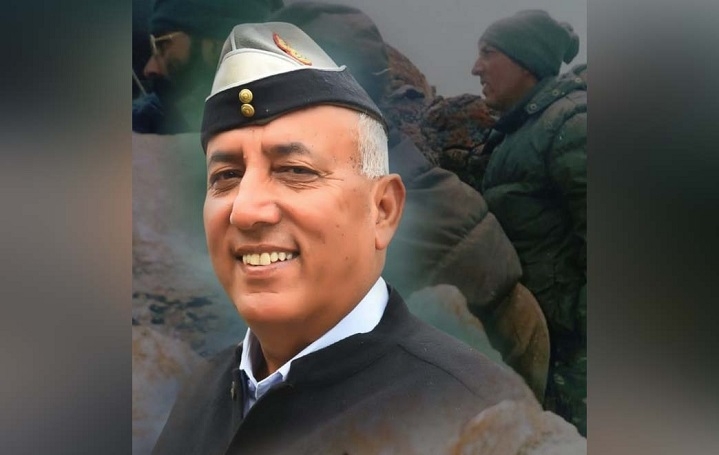25 years of Kargil Retd 18 Grenadiers commandant recalls Tololing battle, deputy’s final moments
| Date :22-Jul-2024 |

Brig Khushal Singh Thakur (retd.), who was the
commanding officer of the
18 Grenadiers that captured Tololing and Tiger Hill
during Kargil war. (PTI)
By Bhanu P Lohumi :
SHIMLA
TWENTY-FIVE years since the Kargil War, Brig Khushal Singh Thakur (retired) vividly remembers to this day the moment his second-in-command in the 18 Grenadiers Lt Col R Vishwanathan breathed his last on his lap during the battle of Tololing. “It was agonising. He was not required to go to the front and could have stayed back at the administrative base, but since I decided to go, he insisted on accompanying me,” Thakur recalled.
Thakur’s regiment, along with the 2 Rajputana Rifles, had captured the Tololing peak, which proved to be a turning point in the 1999 war as it allowed India to get a foothold in the enemy’s defensive layout and then proceed to clear the other intrusions such as the Tiger Hill in Dras sector of Ladakh’s Kargil district.
Speaking to PTI on Saturday, Brig Thakur (retired) took a walk down memory lane, remembering the battle to reclaim the pivotal Tololing peak. “We had taken over the approach to Tololing but a few bunkers at the top were still standing... The fighting was confined to the night as the enemy could see the Indian Army approaching on the barren hill during the day and the intensity of enemy firing increased and so did our casualty,” he said.
“On May 29-30, we lost Major Rajesh Adhikari in the bunker area and I decided to lead and give the last push,” Thakur said, adding that the morale of soldiers was down, and “all eyes were on us” to take Tololing.
“Amid heavy automatic, MMG and rocket fire, we started crawling to the top where the bunkers were located and I asked Subedar Randhir Singh to move forward but he was shot dead. “I sensed that my handset was not moving and found that radio operator Ram Kumar had also been shot,” Thakur said. He recalled it was at this time that he heard a shout that Vishwanathan had been hit.
“There was total chaos. Two young officers pulled him behind a boulder but we could not light up anything or provide first-aid as we were just 15 yards from the enemy, who was constantly firing at us.
“We tried to apply bandages but there was heavy bleeding. I put his head on my lap, started massaging and he breathed his last on my lap and that is one moment I always carry with myself and can never forget,” Thakur said.
Vishwanathan was the senior-most officer to die on the front in the war. Thakur also remembered his conversation with the lieutenant colonel from the day before he died.
“A day back, we got a satellite phone and I told Vishwanathan to speak to his wife and children but he asked to let the jawans speak with their families first. Later, the phone battery died due to cold weather conditions and he could not speak to his family members,” he said. Thakur said the enemy had intruded into about 150 square kilometres and was targeting the national highway connecting Srinagar, Drass, Kargil and Leh.
“The operation started on May 22 with no exact information about the enemy, no time for acclimatisation and absence of high-altitude clothing and artillery as it was the first battle and we were
under the impression that there were only a few militants,”
he said. “We lost 34 brave soldiers during the two-month-long battle.”
“However, winning Tiger Hill was easier compared to Tololing as we had realised that it was the Pakistani Army. We had time to prepare, were equipped with multi-barrel rockets, air force support, artillery and the 8 Mountain Division with 120 guns firing at the Tiger Hill,” Thakur added.
The Kargil war was declared over on July 26, 1999, after India successfully pushed back the Pakistani forces that had stealthily occupied important heights in Ladakh.

Indian Armed Forces personnel celebrate Kargil Vijay Diwas Rajat Jayantiat Bhisiana in Bathinda district on Saturday. (PTI)
Aerial display at AFS Bhisiana to mark Vijay Diwas
NEW DELHI,
THE silver jubilee of Kargil Vijay Diwas was celebrated at the Air Force Station in Punjab’s Bhisiana on Saturday with great pride and fervour to honour the bravery, valour and the sacrifices made by Indian bravehearts during the 1999 war. The No.17 Squadron of the Indian Air Force, operating MiG-21 Type-96 aircraft, based then at the Bhisiana AFS participated actively in the operations, undertaking several reconnaissance and strike missions to flush out the enemy troops, the Defence Ministry said in a statement.
An aerial display was conducted which included para-drop by the Akash Ganga Skydiving team, flypast in ‘Vic’ formation by three Rafale jets and three Jaguar fighter aircraft, Slithering and Small Team Insertion and Extraction (STIE) operations by the Mi-17 1V helicopter, and low-level aerobatics by Su-30 MKI fighter aircraft, it said.
The event also witnessed a flypast in the ‘Arrow Head’ and ‘Missing Man’ formations flown by MiG-29 aircraft in the memory of the brave air warriors. The spectators were also mesmerised by the scintillating display by the Air Force Band and Air Warrior Drill Team, the statement said.